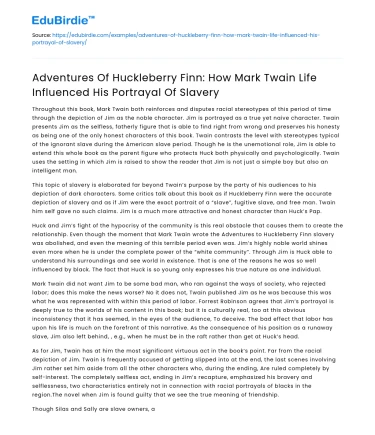Throughout this book, Mark Twain both reinforces and disputes racial stereotypes of this period of time through the depiction of Jim as the noble character. Jim is portrayed as a true yet naive character. Twain presents Jim as the selfless, fatherly figure that is able to find right from wrong and preserves his honesty as being one of the only honest characters of this book. Twain contrasts the level with stereotypes typical of the ignorant slave during the American slave period. Though he is the unemotional role, Jim is able to extend this whole book as the parent figure who protects Huck both physically and psychologically. Twain uses the setting in which Jim is raised to show the reader that Jim is not just a simple boy but also an intelligent man.
This topic of slavery is elaborated far beyond Twain’s purpose by the party of his audiences to his depiction of dark characters. Some critics talk about this book as if Huckleberry Finn were the accurate depiction of slavery and as if Jim were the exact portrait of a “slave”, fugitive slave, and free man. Twain him self gave no such claims. Jim is a much more attractive and honest character than Huck’s Pap.
Save your time!
We can take care of your essay
- Proper editing and formatting
- Free revision, title page, and bibliography
- Flexible prices and money-back guarantee
Huck and Jim’s fight of the hypocrisy of the community is this real obstacle that causes them to create the relationship. Even though the moment that Mark Twain wrote the Adventures to Huckleberry Finn slavery was abolished, and even the meaning of this terrible period even was. Jim’s highly noble world shines even more when he is under the complete power of the “white community”. Through Jim is Huck able to understand his surroundings and see world in existence. That is one of the reasons he was so well influenced by black. The fact that Huck is so young only expresses his true nature as one individual.
Mark Twain did not want Jim to be some bad man, who ran against the ways of society, who rejected labor; does this make the news worse? No it does not, Twain published Jim as he was because this was what he was represented with within this period of labor. Forrest Robinson agrees that Jim’s portrayal is deeply true to the worlds of his content in this book; but it is culturally real, too at this obvious inconsistency that it has seemed, in the eyes of the audience, To deceive. The bad effect that labor has upon his life is much on the forefront of this narrative. As the consequence of his position as a runaway slave, Jim also left behind, , e.g., when he must be in the raft rather than get at Huck’s head.
As for Jim, Twain has at him the most significant virtuous act in the book’s point. Far from the racial depiction of Jim. Twain is frequently accused of getting slipped into at the end, the last scenes involving Jim rather set him aside from all the other characters who, during the ending, Are ruled completely by self-interest. The completely selfless act, ending in Jim’s recapture, emphasized his bravery and selflessness, two characteristics entirely not in connection with racial portrayals of blacks in the region.The novel when Jim is found guilty that we see the true meaning of friendship.
Though Silas and Sally are slave owners, and Jim is the runaway worker that they get caught, they are really good to him, as they exist with their different slaves. Twain’s depiction pf slaves owners is much kinder than figure described by abolitionist. That is understandable, as Twain is the white person who will identify with slave owners, and Douglass is the worker, who will distinguish with all the different enslaved africans of his time. While both Twain and Douglass write of this classical Africans-endlaved-to-white-men story, their depictions of labor are very different. Douglass discovers that vicious force committed upon slaves, while Twain writes of no force against slaves. Abolitionist also depicts labor as harmful to upon slaves and slave owners, and once more, Twain does not. It is clear that there is the good line between realism and fiction when it comes to this depiction of labor. Never again will this human beings commit much sins against one of their own. Twain’s use of irony in his writing is very effective. He uses a lot of irony throughout the book to show how slavery was wrong and unjust when it came to the African-American community.






 Stuck on your essay?
Stuck on your essay?

